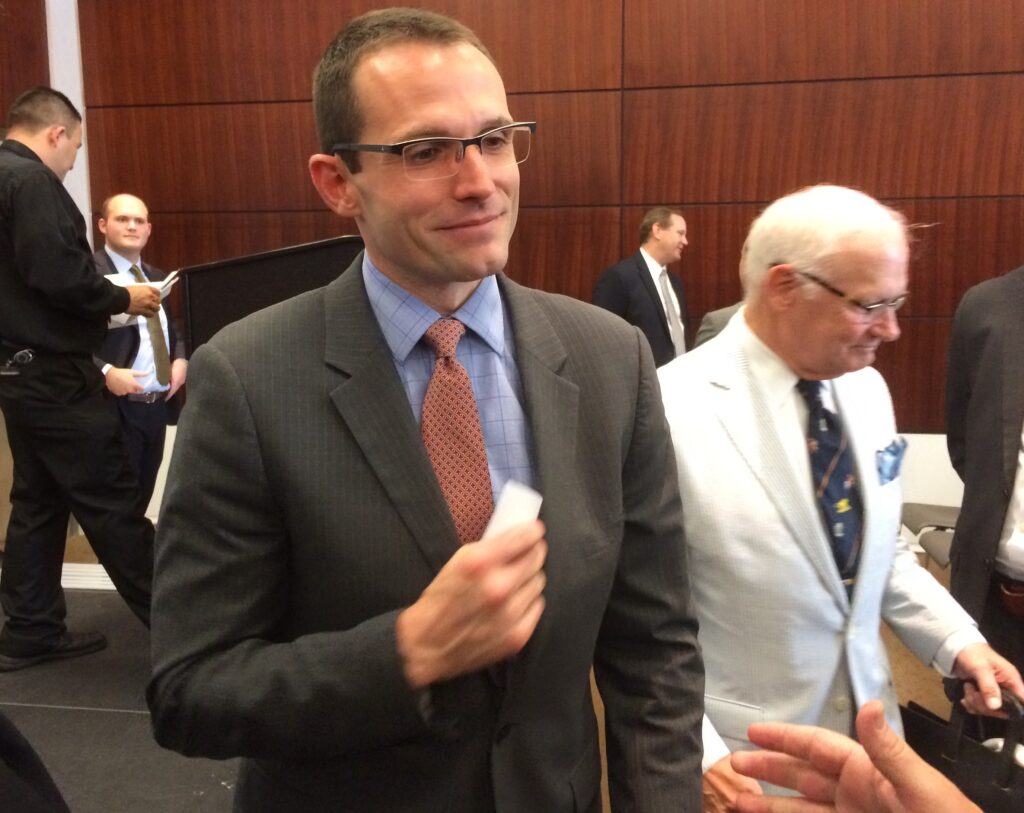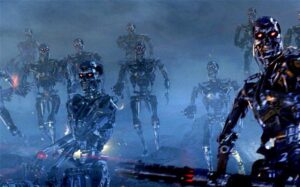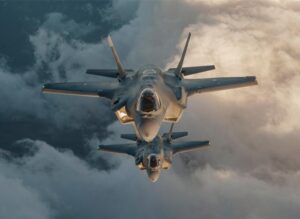
William Roper
AFA HQ: William Roper, the man who’s helping shape that future at the well-named Strategic Capabilities Office, told a packed room here that “stealth won’t last forever;” that adapting to the new version of war he’s helping the country ready for “is going to be harder for the Air Force than the other services;” that the Terminator model of war — with truly autonomous robots acting and reacting and killing — “is a future I just can’t see.”

Terminator army (credit: Warner Brothers)
It was vintage Roper, who was often seen at the right hand of former Defense Secretary Ash Carter.
“Every time you’ve got a story about autonomy in the DoD, you’ve got the required picture of the Terminator right beside it,” he said (yes, we’re guilty as charged). “That kind of autonomy is simply to me, in a future I just can’t see.”
Now that’s a pretty arresting set of concepts but it’s dense. He told us that the way ahead will see “attritable drones” able to collect and distribute huge amounts of data and help protect the humans who actually go to war. In current traditional war plans, the first 10 days of war are usually considered the greatest period of destruction by the air forces. Roper doesn’t think the first days will look like that anymore.
“My prediction is that on the first day of battle when we go fly planes the purpose of the first day or second day won’t be to go out and destroy enemy aircraft or other systems, but to go out and collect data and do basic data recon so our learning system gets smarter than theirs,” he told an audience that had remarkably few Air Force officers in evidence. (I counted four, but may have missed a few.)
How different is this from the system built over the last 30 years? “We are moving in the opposite direction we went in in the Cold War,” Roper said, noting that the system we built against the Soviets was highly centralized and relied heavily on unique technologies that gave us the edge, everything from stealth to GPS. Now, because our competitors have seen how overwhelming our conventional military can be, they are jamming GPS, testing anti-satellite weapons or building DF-21 missiles to kill carriers.
So drone swarms, huge and rapidly mined data sets from clouds of sensors and other systems of systems are the way to go, he argues. They will allow us to move more rapidly and efficiently inside the enemy’s decision cycle than we can now.

Imagine R2-D2 behind the cockpit
My favorite example he offered: “I would love if I could have an R2-D2 sitting in the Joint Strike Fighter that’s not just learning from what the pilot in the Joint Strike fighter is doing, but something very similar to what Tesla cars — is taking data from all the other Joint Strike Fighters and helping that pilot make better choices, suggest courses of action, say, ‘I think you’re running out of fuel,’ or whatever it is the pilot is too saturated may be too saturated with the mission to have time and bandwidth to put on it.”
Tesla cars, he said, “are members of a team that learn together. I think that has power in air, at sea and on land… Our data right now is passive. It needs to be working for us.”
There’s been much speculation about whether the SCO, DIUX and other nimble advanced technology efforts started by the last administration will be cast aside because they are too closely associated with Obama. So I asked Roper if he expected his office to survive, or if he’d been given any encouragement by Defense Secretary Jim Mattis. He wouldn’t answer either question, which is not unreasonable as the issues are central to the budget –which has not been released. But the fact that he is appearing in public and forging ahead seems pretty good evidence that, at least, the SCO will survive.
Move over FARA: General Atomics pitching new Gray Eagle version for armed scout mission
General Atomics will also showcase its Mojave demonstrator for the first time during the Army Aviation Association of America conference in Denver, a company spokesman said.


























